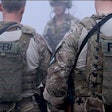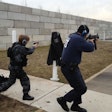Anyone who's ever had to search a dark, confined space for dangerous, hidden suspects fully understands the true meaning of "adrenaline-driven pucker factor." In "Searching for Hidden Suspects," tactical experts Dean Scoville and Don Alwes made a strong case for employing SWAT for hidden, dangerous suspects.
Dean points to SWAT's access to sophisticated equipment, while Don points to SWAT's "time, tactics, and troops." To which I'd add "technology, training and techniques." For these reasons, SWAT teams are search specialists, and rightfully expected to be proficient doing them safely and successfully.
SWAT should use all their "6 Ts" to advantage when ferreting out hidden suspects, including using whatever sophisticated technology you have available to you. Oftentimes, the results are success, and hidden suspects are spotted and surrender without incident.
Inevitably though, there comes a point when, as Cleveland PD SWAT Sgt. Tom Horan eloquently stated, "Eventually someone has to stick their 'tomato' in there." Of course, "tomato" being the head and "there" being an attic, basement, closet, or crawl space.
I honestly can't recall receiving any formal suspect-search training for confined spaces, while in Cleveland PD's tactical unit. We learned primarily through OJT (on-the-job training), as well as tactics, techniques, and lessons from ourselves and others. Over time and with more experience conducting countless suspect searches, certain tactics and techniques proved to be more successful (and safe) than others.
When it comes to SWAT, the liveliest debates are often the ones over tactics. I can easily imagine a room full of experienced SWAT operators discussing confined-space tactics. Very soon, it would become apparent each and every team has their own personal preferences of what works and what doesn't.
If there's one thing tactical personnel train and specialize in, it's suspect searches. SWAT teams train with sophisticated equipment and unique tactics to safely ferret out hidden, dangerous suspects.
In spite of all the tools and training available, at some point, as Tom Horan correctly pointed out, someone has to physically search the location.
The stark, unsettling reality is how easy it is to miss finding hidden suspects. One of the very worst feelings any LEO can experience is missing hidden suspects during searches.
Missing hidden suspects places everyone involved in extreme danger, especially when a location has been declared secure. Patrol, detectives, or SWAT can, and sometimes have, missed finding suspects. The tragic or deadly consequences could have been avoided.
In "Duty Dangers: Into the Hearts of Darkness," Dean Scoville correctly points out that LEO's can, as with the rest of the population, have phobias. When it comes to confined space searches, these phobias can include spiders, rats, creepy-crawlies, or claustrophobia. Few officers, especially in SWAT, will volunteer, or admit, they have phobias.
Consequently, such phobias tend to manifest themselves during confined-space searches. And usually only when someone is confronted with having to search a small, one way in/out, confined space for a hidden, dangerous suspect. Not only is there danger from the suspect, but also from the rats, spiders, snakes, the dark, or limited access.
It takes a special officer to willingly, capably, and effectively search confined spaces for suspects. During the Vietnam War, "tunnel rats" were employed to search the often elaborate, always extremely hazardous NVA/VC tunnel systems.
Tunnel rats were physically and mentally tough, as well as small, but wiry in stature, and usually equipped with only handguns and flashlights. These "rats" weren't Spec Ops, but from the ranks of ordinary troops. Tunnel rats proved very highly effective against NVA/VC tunnels, but often at a very highly deadly price to the "rats." So dangerous, often their tunnel tours had to be limited to four months.
The current Afghanistan War today also involves tunnel warfare, and as with their predecessors in Vietnam, tunnel rats once again face great danger while ferreting out hidden enemies.
Their use has proven effective enough that LE, and particularly SWAT, needs to take a very strong look at employing them. After all, SWAT is expected to be able to emply special tactics to resolve hazardous situations.
What more hazardous situation exists in LE than searching for a hidden suspect in a confined space?
While all SWAT officers need to be cross-trained in a variety of capabilities, certain sub-specialties should be cultivated, such as breachers — who necessarily need to be bigger, more powerful than average — or counter snipers who need to be top shots with precision rifles.
Another sub-specialty every tactical team needs to have is tunnel rats. Someone physically, and especially mentally, suited to be willing and capable of effectively searching confined spaces for hidden suspects.
This isn't a job for everyone. While your biggest, strongest officer might make the ideal breacher, he's probably too big to fit into small confined spaces, such as crawl spaces so small and nearly inaccessible, that the only way to search is for a smaller statured tunnel rat to crawl flat on his stomach. A breacher will likely be unable to fit in such tiny spaces.
Tunnel rats need to be able to overcome spiders, rats, snakes, and other hazards and engage in up-close, physical, and armed combat with a cornered, dangerous, determined and barricaded suspect with no room to maneuver and without backup.
Where do tactical teams find such tunnel rats? Are tunnel rats born or can they be made? And what makes an effective tactical tunnel rat? What tactics or techniques work effectively?
Related:
Detroit Officer Shoots Burglar During Scuffle In Beauty Store's Dark Basement
















